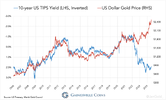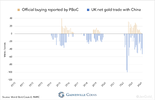- Joined
- 13 February 2006
- Posts
- 5,378
- Reactions
- 12,477

Full: https://www.coindesk.com/policy/202...rtly-by-revaluing-feds-gold-draft-bill-shows/
Every $4000oz = $1T
So gold at $20,000oz = $5T which brings debt back to $30T. LOL.
jog on
duc

Thanks duc @ducati916
some ETFs but am not sure about other trading ( ASX or commodities )I just noticed when I checked my calendar for the week that tomorrow is a bank holiday in NSW.
Does this affect Gold Trading or ASX via Sydney or elsewhere tomorrow?
gg
not ASX ...I just noticed when I checked my calendar ...tomorrow is a bank holiday in NSW.
Does this affect Gold Trading or ASX via Sydney or elsewhere tomorrow?
Thank you, GG, got it now. Much appreciate that.@eskys and @Sdajii . This the link that @qldfrog used I believe to get the spot Gold price.
Gold Price Today | Price of Gold Per Ounce | 24 Hour Spot Chart | KITCO
Live Gold Charts and Gold Spot Price from International Gold Markets, Prices from New York, London, Hong Kong and Sydney provided by Kitco.kitco.com
It will sometimes have a blocker asking you to turn off your adblocker.
Just click on the x in the top right corner of the pop up and you are in the site.
gg








You are not wrong Eskys, just have a look at the gold chart.In a downward market, generally speaking, all sectors get pulled down with it. Regardless of the price of gold, ie up, our gold miners will get pulled down with it...hope I'm wrong there.

Unfortunately for miner holders you may be correct @eskys . The diggers don't seem to have made as much as they should have out of the rise in the POG.In a downward market, generally speaking, all sectors get pulled down with it. Regardless of the price of gold, ie up, our gold miners will get pulled down with it...hope I'm wrong there.

There will be bargains to be had when all this settles. A matter of time and patience...timing is critical to making or breaking the bank.You are not wrong Eskys, just have a look at the gold chart.
Every stock I own in the PM's market is down, despite the gold increasing in price, and its only a piker away from its recent ATH.
Hoping like hell that this rout continues for the rest of the week or even longer.
There will be some gold bargains to be had.
Mick
View attachment 182057
Unfortunately for miner holders you may be correct @eskys . The diggers don't seem to have made as much as they should have out of the rise in the POG.
This is an image from April this year comparing NYSE listed miners v POG.
It also shows that even in the 2020 recession the miners only had a brief gain before going contra to Gold itself.
View attachment 182058
Read an article a while ago that it's expensive to process gold. High interest rates here aren't helping...the costs keep on escalating. Price of gold go up, but the costs associated with mining and processing negates this....something along those lines. That's how I read it.I often wonder about the disparity between the POG and the price of Gold Miners.
The only sensible reason that. comes to me is that there is sufficient tradable Gold within the trading space, that it is fixed in tonnage and that new Gold going in to the famous two swimming pools just meanders out to the Mrs Mugabe's of the world.
I know the miners have hedges in place but I don't understand who to or where they sell their Gold. So a miner digs and reduces all the hours and impurities to Gold, and then has Gold bars. Where do they go next? The hedging is paper Gold, so how do they swap the yellow for the paper Gold and then in to cash profit.
Anyways just a brainf*rt nobody here on ASF probably wanted to be close to.
gg
well Russia doesn't hoard all the gold it mines ( although i did hear 90% at one stage ) and Russian gold is unpopular on some exchanges so i imagine Russia sells a few bars for yuanThe "revelation" that China's P Central bank had stoipped buying gold was given as one of the reasons for the precious metals pull back recently.
Not everyone believed the official Chinese stats of course, but it was enought to rein in the gold price.
But now Gainsville coins points that the PBOC merely bought Bullion from Western Banks, rather than on the open market.
This article is an analysis of how the Chinese central bank (PBoC) buys gold in London from Western bullion banks. Because the bullion banks take care of the gold transport for the PBoC, the shipments from London to Beijing are disclosed in UK customs data. The customs data reveals that the PBoC continued to buy gold in May—when it communicated to the market it discontinued buying—at a rate of 53 tonnes. The PBoC stated it stopped buying to dampen the gold price so it could acquire more gold.
Several months ago, I discovered that supply in the Chinese gold market was outstripping demand. During my investigation of this anomaly, I found circumstantial evidence that led me to conclude the surplus is imported in 400-ounce bars from the United Kingdom, and surreptitiously procured by the PBoC.
Let’s go through some of the mechanics of the global gold market before we can stitch it all together.
PBoC Gold Buying Hidden in Plain Sight
In global customs data—officially called International Merchandise Trade Statistics (IMTS)—all gold disclosed is “non-monetary,” meaning not owned by a monetary authority such as a central bank. In the United Nations IMTS rulebook it reads that customs data excludes monetary gold:
Since monetary gold is treated as a financial asset rather than a good, transactions pertaining to it should be excluded from international merchandise trade statistics.
Though, someone familiar with the matter but who prefers to stay anonymous, shared with me that gold import and export data can relate to monetary gold. Commonly, central banks will buy gold from Western bullion banks that arrange transportation and insurance of the metal. The moment these banks ship the gold from the UK it is thus non-monetary bullion, but when it arrives in China it is monetized (changes ownership) and brought to vaults of the central bank, supposedly in Beijing.
Exports from the UK are mainly from the wholesale gold market in London where virtually all bars traded weigh 400 ounces. The retail market in Britain dealing in smaller bars pales in comparison, and the refining industry in the UK is relatively small.
In turn, at the core of the Chinese domestic gold market, which excludes Free Trade Zones (FTZs), is the Shanghai Gold Exchange (SGE) where predominantly 1Kg gold bars are traded.
The private sector in China trades 1Kg bars through SGE, while the central bank buys “large bars” (400-ounce bars) abroad. As all gold on the SGE is traded in yuan, the PBoC can only diversify its international reserves by buying gold overseas with dollars or other foreign exchange. Aside from logic, there are multiple sources that have made clear the PBoC doesn’t purchase gold on the SGE. For example, the World Gold Council (WGC, page 9), the SGE (page 4), and it was confirmed to me personally by an ex-gold trader from a Chinese state-owned bank.
The SGE captures the lion share of all gold trading in the Chinese private market. There are rules and incentives that steer most supply—imports, domestic mine production, and recycled metal—towards the SGE, which for liquidity reasons attracts most demand. Hence, the gold withdrawn from the SGE vaults is often used as a proxy for Chinese wholesale demand. In a formula:
SGE withdrawals = net import + domestic mine output + recycled metal
View attachment 182048
Before 2022, gold supply and demand in the Chinese market matched. SGE withdrawals were always higher, to varying degrees, than net import plus domestic mine output, the difference being gold recycled through the central bourse.
If it were true that bullion banks ship gold to China, as non-monetary gold visible in customs data, that doesn’t flow into the SGE system, we would see a discrepancy between apparent Chinese gold supply and SGE withdrawals. As more gold would be supplied to China than sold through the SGE. In a formula:
SGE withdrawals < net import + domestic mine output + recycled metal
View attachment 182049
Indeed, both in 2022 and 2023 China’s net import plus mine output transcended SGE withdrawals (let alone if we would add recycled gold).
View attachment 182050
As we shall see, the surplus in the Chinese gold market—imports that are not sold through the SGE—is being absorbed by the PBoC.
Readers with deep knowledge of the Chinese gold market might think: “what if the large bars are refined in FTZs and loaded into SGE vaults without being withdrawn?” I checked with a source that has connections to refineries in China, and according to this person the refineries don’t use any large bars as feedstock for producing 1kg bars for the SGE*. Another contact I have, close to the SGE, shared with me that SGE inventory in April 2024 accounted for about 300 tonnes. Inventory had gone up recently together with a rise in the price of gold, this person said. However, the increase in SGE inventory can’t make up for the surplus in the market, which is at least 400 tonnes according to my calculations.
More Data Supporting the Thesis
By comparing estimated central bank purchases by the WGC, based on field research, to official statistics regarding gold buying by central banks, we know that since the start of the Ukraine war, in February 2022, monetary authorities in aggregate are secretly buying much more than they report. I have written before that these covert purchases can be attributed for roughly eighty percent to the PBoC.
View attachment 182047
“Unreported” PBoC gold purchases exploded when $300 billion in foreign exchange reserves from the Russian central bank were frozen by the West early 2022 due to the war. Notably, the UK began exporting 400-ounce bars to China in huge tonnages at the same time. Coincidence? I think not. Ever since, China has taken over gold price control from the West and broke the gold price’s correlation with “real rates” (10-year TIPS yield).
View attachment 182051
Chart 6. The UK’s direct export to China is likely destined for the PBoC.
View attachment 182052
The final clue is that there is a relationship between what the Chinese central bank officially reports to be accumulating, and gold exports from the UK to China. What frequently happens, exposed by comparing these numbers, is that the PBoC starts buying gold a few months before it tells the world about it, and severely underreports its additions. This was the case in 2015, 2019, and 2022.
View attachment 182053
Chart 8. Official data on PBoC gold buying versus UK gold exports to China. Previous exports from the UK for the PBoC were not large enough to create an apparent surplus in the Chinese gold market.
Conclusion
It all fits and makes sense: the motive, the data, and the anecdotal evidence. Let’s summarize our key findings:
- The Chinese central bank desperately needs to diversify its foreign exchange reserves since the beginning of 2022. Since then, the PBoC secretly buys large amounts of gold.
- At the same time, export of large gold bars from the UK to China explodes.
- A “surplus” in the Chinese market appears, while the bullion is not to be found in SGE vaults. As if it has gone up in smoke.
- A source indicates that gold shipments for central banks are often included in customs data.
- There is a correlation between PBoC official buying and UK exports to China, suggesting the Chinese central bank buys gold in England’s capital and lets banks supervise transport (maybe because the PBoC reaches the limits of its own capacity to ship gold when volumes are sizable).
It all points towards UK gold exports to China are destined for the PBoC—although probably not every ounce of these flows is for the Chinese central bank. Clearly, the PBoC is accumulating more gold than it wants to disclose.
When the PBoC stated it had stopped buying gold in May 2024, after continuous purchases for 18 months, I didn’t believe it. The PBoC has few reasons to cease growing its gold reserves in the current geo-political and monetary landscape with a plethora of challenges.
View attachment 182054
Click on the image to view the tweet on X.
Probably, the PBoC wants the most gold for its dollars, so when the price rises fast it will signal it stopped buying, trying to cool the market. In the meantime, the United Kingdom exported 53 tonnes to China in May, of which likely most found its way to Beijing.
Note, the PBoC also buys in Switzerland and other countries, flows that can be included or excluded in customs reports, but it’s impossible, from where I stand now, to measure all these separately.
Finally, some of my previous analyses have been skewed by the above. Private demand in China has been lower because some (“non-monetary”) imports were taken by the central bank.
Well researched I believe.
Mick



It seems that the Chinese will go to no end to get gold into their country without letting it add to the official figures.The "revelation" that China's P Central bank had stoipped buying gold was given as one of the reasons for the precious metals pull back recently.
Not everyone believed the official Chinese stats of course, but it was enought to rein in the gold price.
MickJust a normal everyday traffic stop: pulling over a couple of Chinese nationals, driving through Texas, with $250,000 worth of gold bars on their person.
That was the scene last week in Van Zandt County, according to KETK NBC.
Sgt. Charlie Hughes of the Wills Point Police Department was monitoring traffic on I-20 near the 533-mile marker when he saw a White Chevy Malibu with Michigan plates committing a traffic violation.
He then stopped the vehicle and identified the driver as 25-year-old Weijian Chen.
KETK writes that due to a language barrier, Hughes asked Chen to use a translator app in his patrol vehicle to communicate.
The officer said that during the interview he “observed multiple factors that lead [him] to believe there was criminal activity afoot.”
The driver said that he was heading to Dallas and had also been in Florida to "play".
The vehicle was rented under the name of the passenger, 46-year-old Wenqiang Lin, who consented to a search but appeared uncertain. A K9 unit alerted to the front passenger door.
A bag behind the driver's seat contained gold bullion bars worth an estimated $200,000 to $250,000, including:
After arresting Chen and Lin, Sgt. Hughes contacted U.S. Homeland Security, which revealed both men had entered the country illegally. Lin entered on September 15, 2023, and was awaiting immigration processing in Los Angeles. Chen entered on December 17, 2023, and is also pending immigration judicial action.
- Seven 1-ounce 999.9 gold bars
- Three 5-gram 999.9 gold bars
- One 1-gram 999.9 gold bar marked with 20 squares
- Eight 10-ounce 999.9 gold bars
“Based on my training, I know that it is very unlikely that Lin or Chen could have transported the gold bullion through airport Transportation Security Administration security checkpoint with[out] filing a United States Currency Transaction Report,” the officer said.
KETK wrote:
During an interview at the Van Zandt County Jail, Chen allegedly stated that the gold bars had been given to him by someone to transport to Dallas however he declined to give any further information.
Both suspects have been charged with money laundering and are being held on $100,000 bond.
Hello and welcome to Aussie Stock Forums!
To gain full access you must register. Registration is free and takes only a few seconds to complete.
Already a member? Log in here.